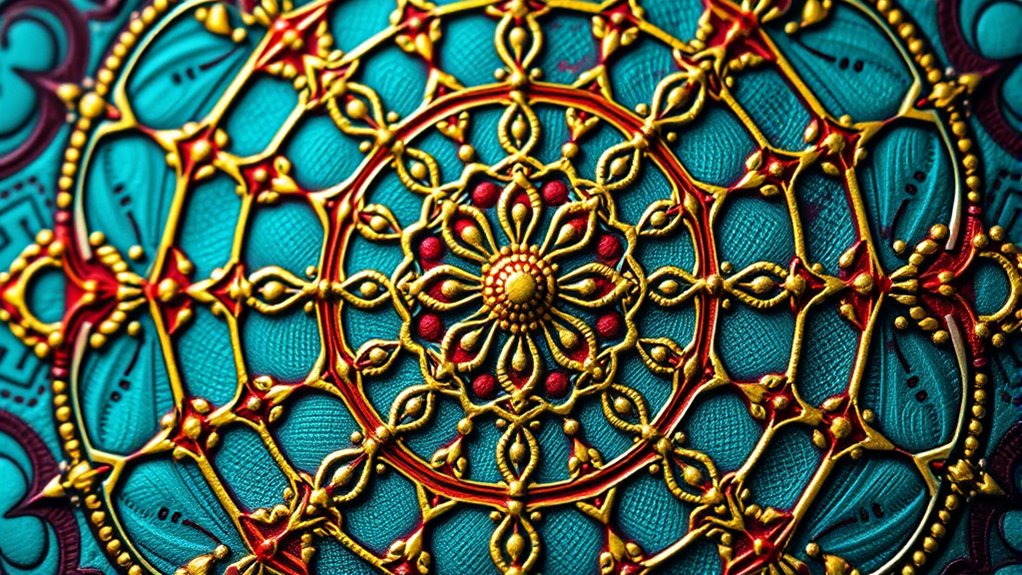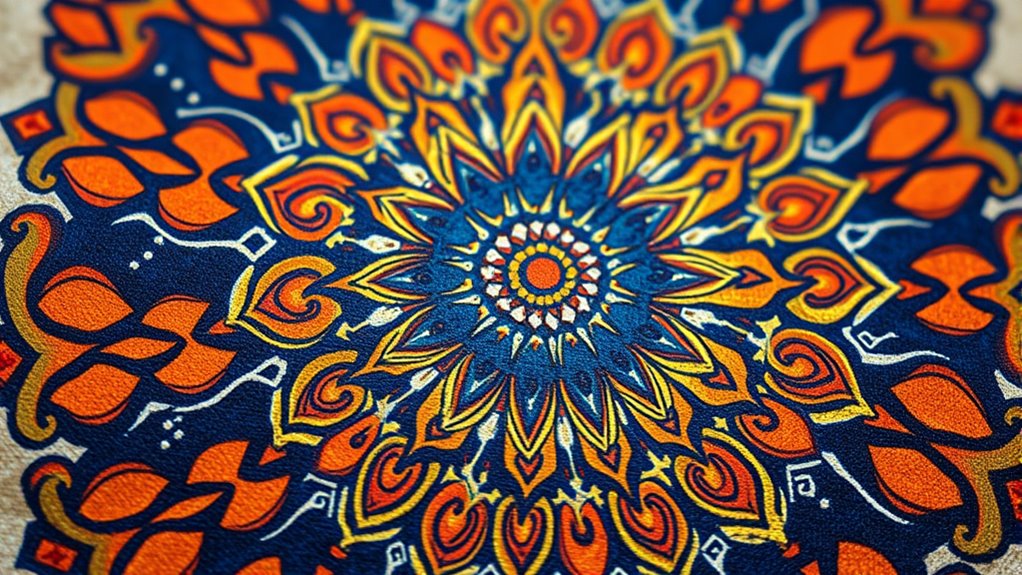Mandalas mirror your mind by reflecting your thoughts, emotions, and inner state through their intricate, symmetrical patterns and symbolic designs. When you create or observe them, you focus deeply, which helps calm your mind, promote clarity, and foster self-awareness. These patterns reveal pathways to inner calm and understanding, making them powerful tools for personal growth. If you keep exploring, you’ll uncover even more about how mandalas can help you connect with your true self.
Key Takeaways
- Mandalas reflect the mind’s inner landscape through symmetrical, symbolic patterns, revealing subconscious thoughts and emotions.
- Creating and interpreting mandalas promotes self-awareness by mapping personal feelings, thoughts, and psychological states visually.
- They serve as tools for mindfulness and emotional regulation, helping individuals understand and manage their mental and emotional patterns.
- Mandalas’ repetitive designs foster focus and clarity, illustrating how mental processes organize and structure inner experiences.
- Studying mandalas enhances insight into cognitive and emotional functioning, emphasizing their importance in mental health and personal growth.

Mandalas have long been recognized as powerful tools for calming the mind and fostering inner focus. When you engage with them, you’re not just creating or observing intricate designs; you’re tapping into a deeply rooted practice that enhances your meditative benefits. As you trace, color, or simply contemplate a mandala, your mind begins to quiet, distractions fade, and a sense of centeredness emerges. This process helps you access a meditative state, reducing stress and promoting emotional balance. The repetitive, symmetrical patterns act as visual anchors, guiding your attention inward and encouraging mindfulness. By dedicating time to this artistic activity, you cultivate a sense of calm that extends beyond the moment of creation, positively influencing your overall mental well-being.
At the same time, working with mandalas offers a unique form of artistic expression that bridges creativity and introspection. You have the opportunity to interpret patterns and colors in ways that resonate personally, making each piece uniquely yours. This artistic process isn’t about perfection but about connection—your inner thoughts and feelings are reflected through your choices in design, color, and form. Creating mandalas becomes a therapeutic act, allowing you to explore your emotions visually and symbolically. The act of designing or coloring a mandala can serve as a form of self-discovery, helping you articulate feelings that are difficult to put into words. As you experiment with different styles or color schemes, you develop your artistic voice, gaining confidence and insight into your inner world.
Furthermore, engaging with mandalas as artistic expression enhances your ability to focus deeply. The detailed, symmetrical nature of these designs requires concentration, which in turn sharpens your attention span. This focused attention isn’t just about the art itself; it’s a training ground for greater mental clarity and discipline. As you immerse yourself in the creative process, you learn to block out distractions and stay present. Over time, this improved focus transfers to other areas of your life, helping you approach tasks with more patience and mindfulness. Additionally, mindfulness practices such as working with mandalas can improve your overall mental health and resilience. Whether you’re coloring a mandala or designing one from scratch, you’re practicing a form of active meditation that nurtures both your artistic talents and mental resilience, making it a meaningful practice for holistic well-being.
Frequently Asked Questions
Can Mandalas Help Improve Mental Health?
Yes, mandalas can help improve your mental health. By engaging in mindfulness meditation with mandalas, you focus your attention and calm your mind. Creating or coloring mandalas encourages emotional regulation, letting you process feelings and reduce stress. Regular practice can enhance your self-awareness and promote relaxation. So, incorporating mandalas into your routine offers a simple, effective way to support your mental well-being.
Are Mandalas Culturally Specific or Universally Applicable?
Imagine a circle, embodying unity and wholeness—this is the essence of mandalas. While cultural symbolism and spiritual significance vary worldwide, the core concept remains universal. You’ll find mandalas resonate across diverse traditions because they tap into shared human longing for connection and understanding. Their beauty lies in their adaptability, allowing you to explore personal meaning regardless of cultural background, making them both culturally specific and universally applicable tools for introspection.
How Do Mandalas Influence Brain Activity?
You might wonder how mandalas influence brain activity. When you engage with them, they stimulate neural pathways, promoting focus and relaxation. This process helps reshape cognitive patterns, reducing stress and enhancing creativity. As you trace or meditate on a mandala, your brain enters a calm state, strengthening connections that support mindfulness. Fundamentally, mandalas act as visual tools that guide your mind toward balance by modulating neural activity.
Can Creating Mandalas Foster Personal Growth?
Creating mandalas isn’t just art; it’s a journey inward. You can foster personal growth through mindful focus and creative expression, which deepen self-awareness and emotional resilience. While it may seem simple, this act cultivates mindfulness benefits, helping you stay present and calm. Juxtaposing the complexity of your inner world with the symmetry of a mandala reveals insights, encouraging transformation and growth from within.
What Scientific Evidence Supports Mandalas’ Therapeutic Effects?
Neuroscience research shows that creating mandalas can activate brain regions involved in focus and emotional regulation, supporting their therapeutic effects. Art therapy studies indicate that engaging in mandala-making reduces stress and enhances mindfulness. You can benefit from this by using mandalas as a calming practice, as evidence suggests they help process emotions and promote mental well-being through visual and artistic engagement.
Conclusion
By exploring mandalas, you tap into a powerful tool that reveals the hidden depths of your mind. They’re more than just beautiful patterns—they’re gateways to self-discovery and transformation. But what secrets lie within your own design? As you continue to map your inner world, you might just uncover something unexpected—something that could change how you see yourself forever. Are you ready to unseal what’s waiting at the center?











